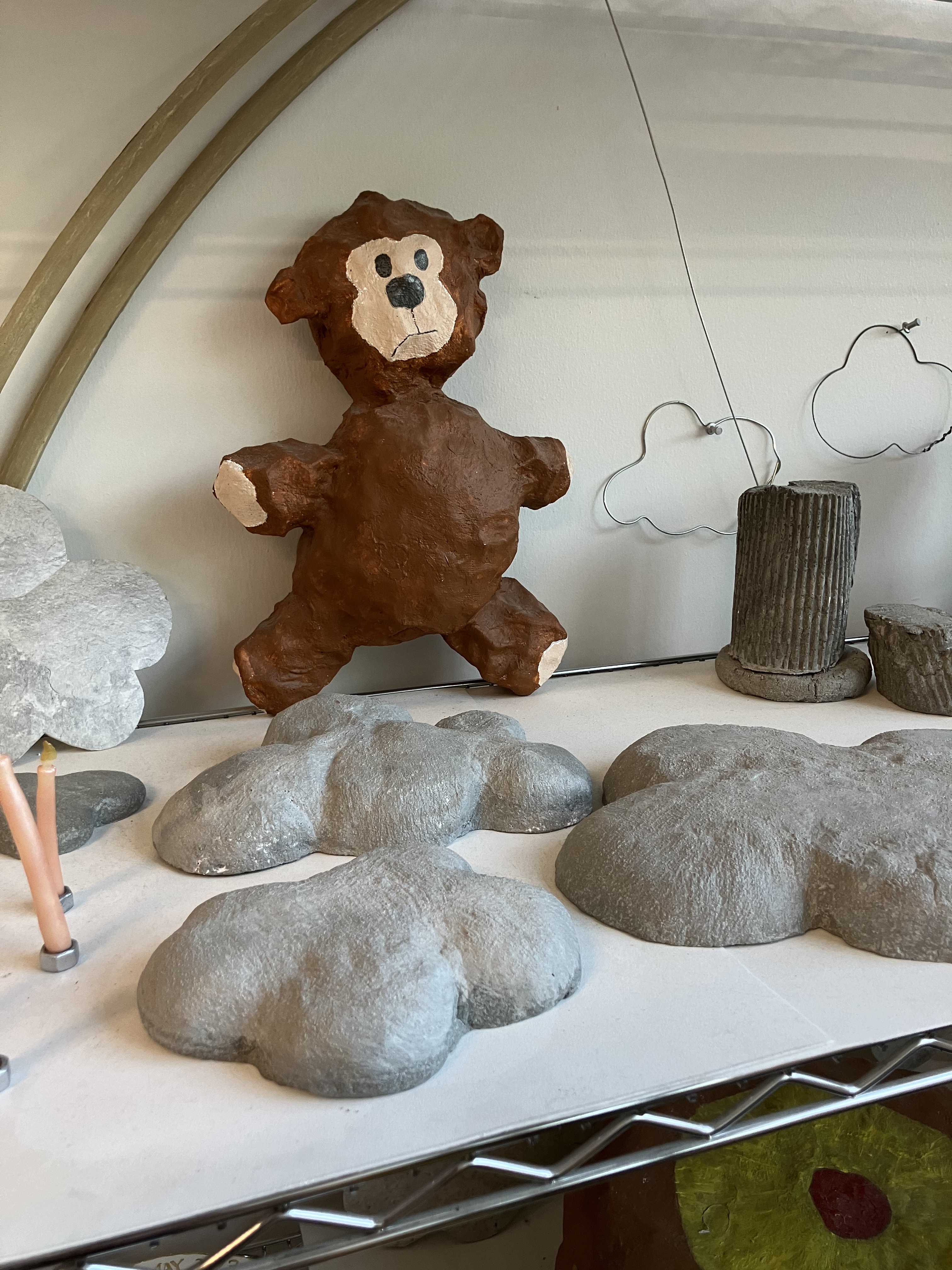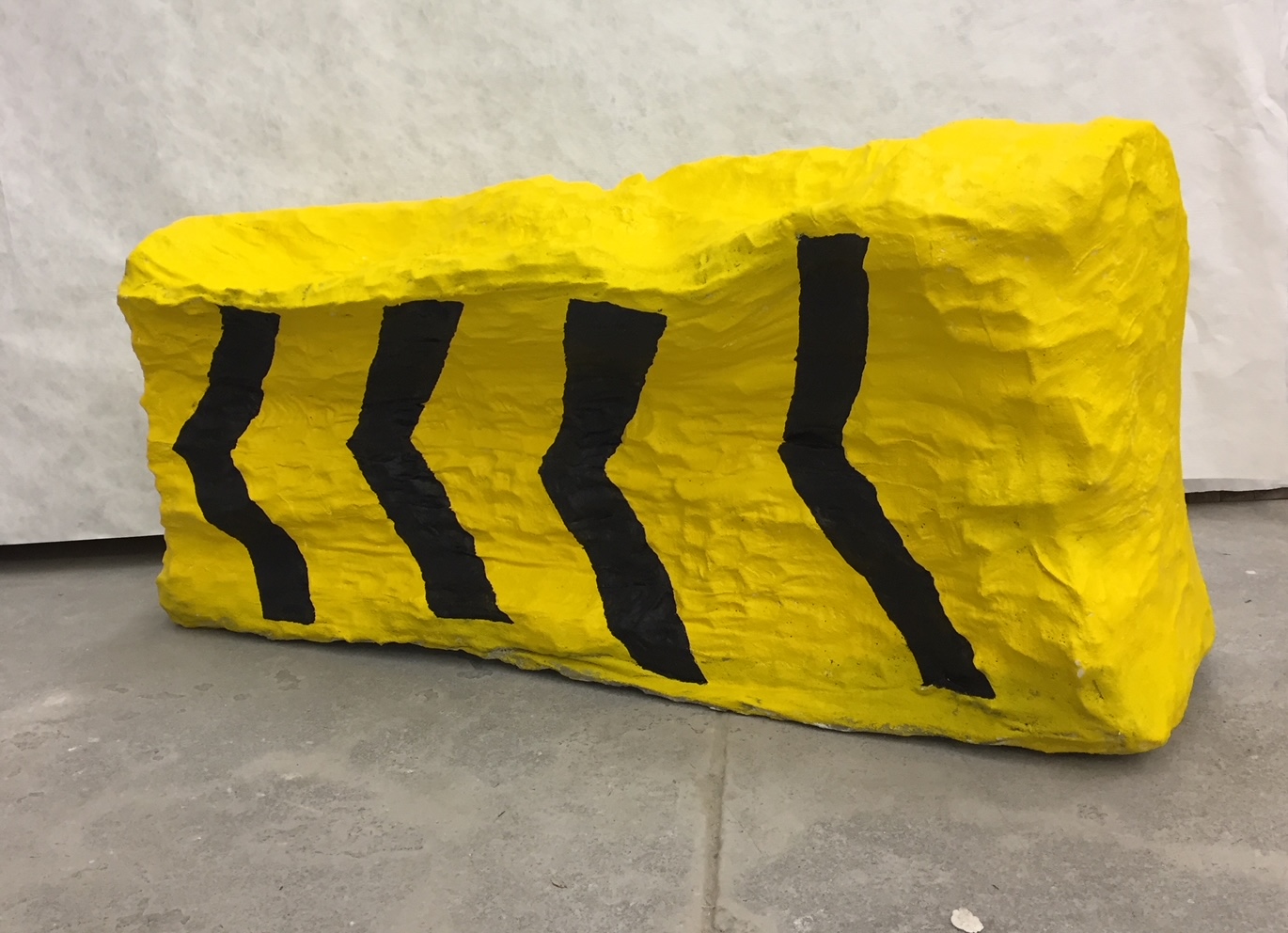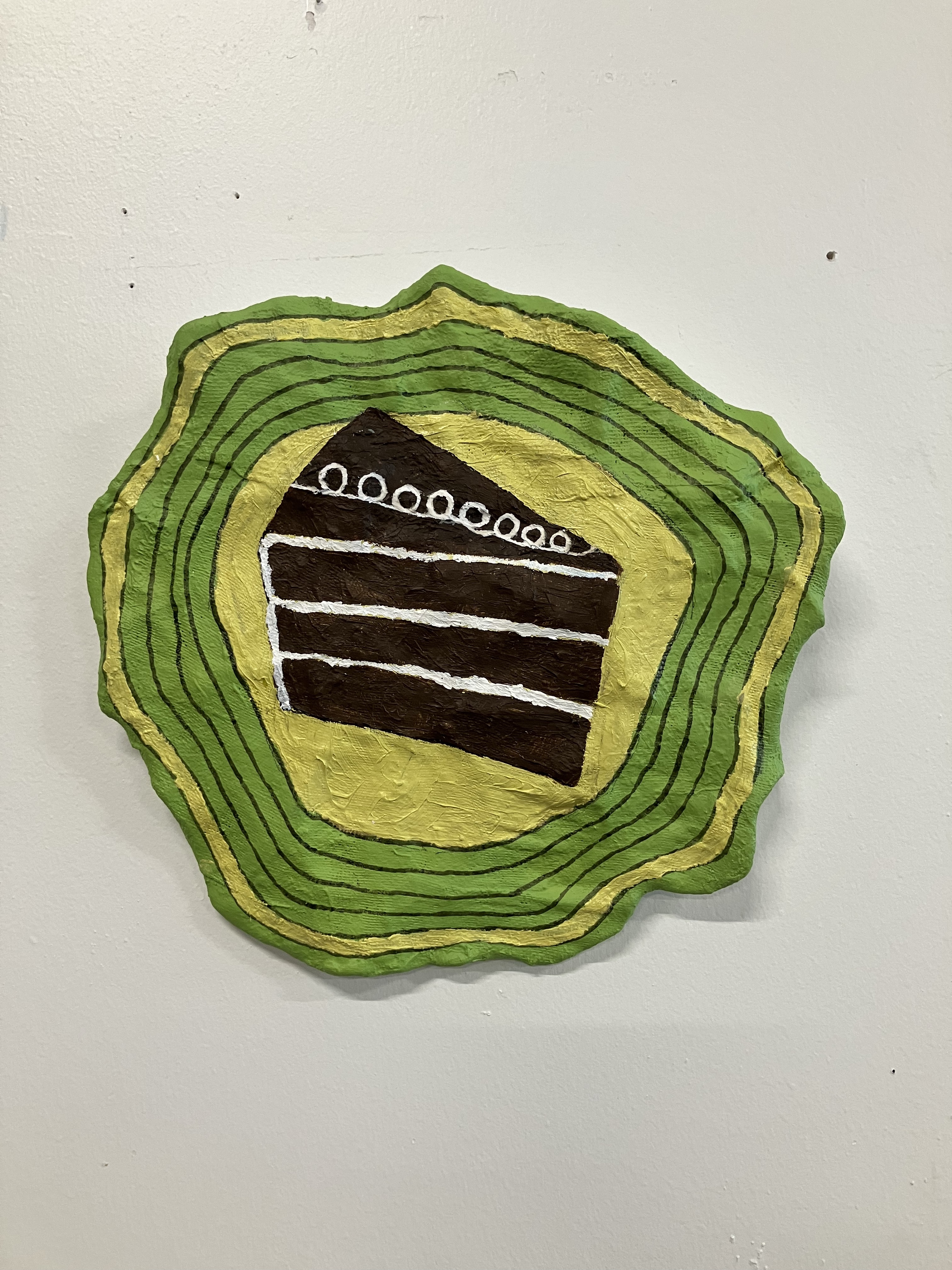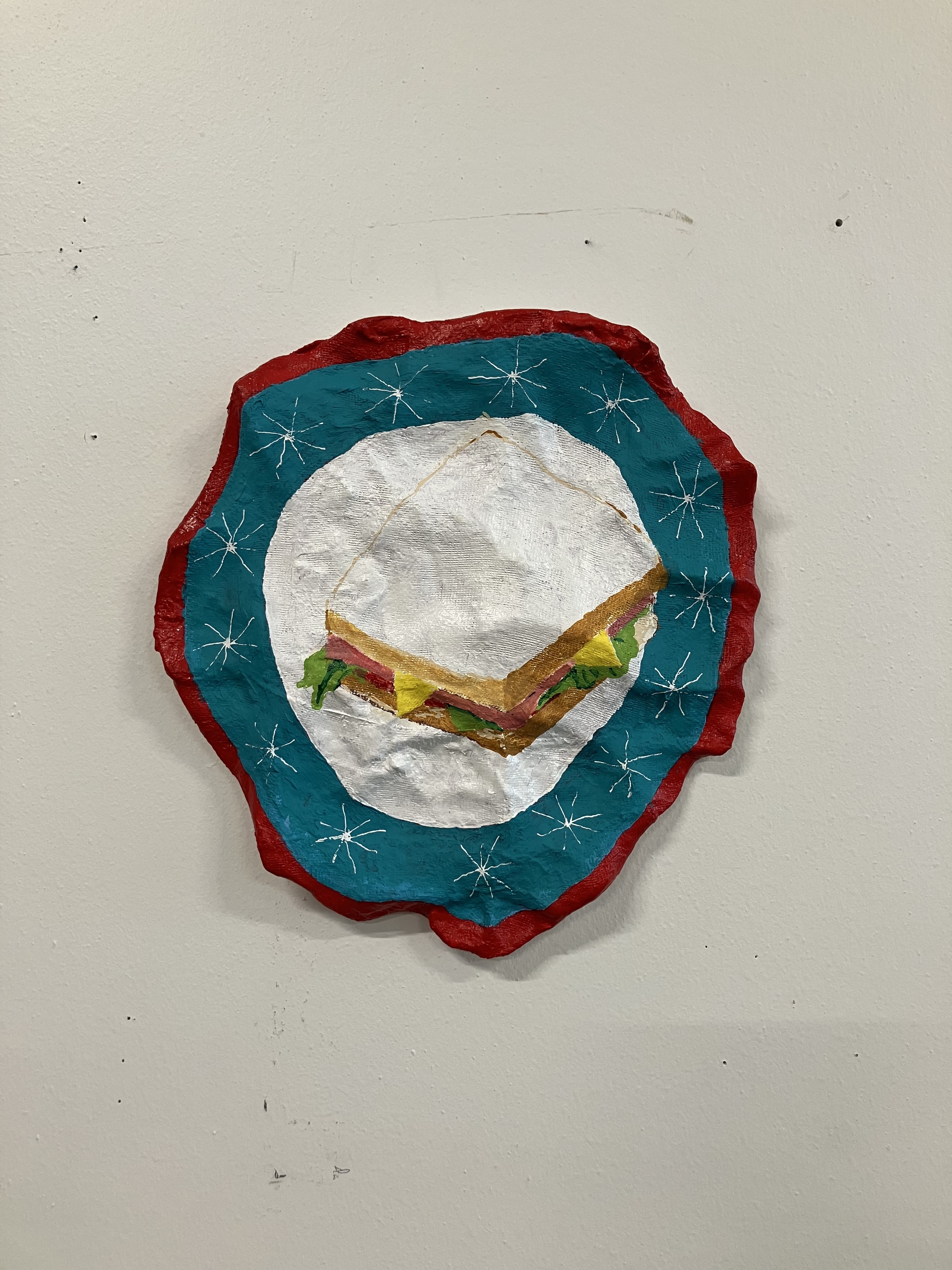
Ashley Cook
October 17, 2024

A: What do you think about doing an interview about the history of your life as an artist living in New York and your experience recently moving back to Detroit?
M: Sure. I came to NYC in 1974 with a BFA in sculpture from Aquinas College in Grand Rapids, Michigan. At Aquinas College, there were two teachers that had a gigantic influence on me, Ron Watson and Winifred Lutz. Aquinas was probably their first teaching gig. They came in fresh, they were working artists, they knew the scene and taught us about it, so I felt when I got to New York, I had learned enough that I ‘knew which way the wind was blowing.’
When I got there, I got involved in a truly happening scene. I was in the right place at the right time.
A: What years were you there?
M: I moved in 1974. My very first apartment was unbelievably fabulous. I shared it with someone who modeled for Marimekko, Anja Vaccaro. Anja was the most stunning woman I had ever seen. She was married to the photographer Tony Vaccaro who photographed food, fashion, and art in the 1950s, 60s, and 70s for Look Magazine. As it turned out that fabulous apartment was owned by drug dealers who had been busted in a huge French Connection style heist and were in jail.
For my BFA thesis show, I tap danced, and that sort of led me to something cool I did in New York.
A: Like literally tap dancing?
M: Yes, it was part of my sculpture installation. When I got to New York, I took a few tap-dancing lessons at Carnegie Hall, and I had a job working right there on 48th and Broadway at the Howard Johnson’s Restaurant. Black vaudeville dancers were in and out of there all of the time. I met a performer named Bert Gibson, one of the original Three Chocolatiers, who wanted to start a chorus line. I knew some people – my girlfriend Ellyn, whose father was the first Sportin Life in Porgy and Bess, helped me get a line together. (Bert’s wife, Sandra, was a famous Lindy Hopper. When you see those old movies and there are Lindy Hoppers dancing all around, one of those gals is Sandra). Burt revived old Broadway show routines because he knew every beat of every instrument of every step for Shuffle Along and others too. It was super cool. We were the Fabulous Gibson Girls.
Myself, Ellyn, Ellyn’s sister Gretchen, Soni and Bobbi were in the first line. We were a hit, performing at the annual Copacetics Ball in Harlem. We rehearsed in the basement of Small’s Paradise and danced at the Old Renaissance Ballroom, Harlem World, and the Savoy Ballroom. It was short-lived, but it was great.

A: So your creative practice at the time primarily involved dancing?
M: No, I sort of hit New York like a kid in the candy store and was doing everything. In the mid 70s, loft jazz was huge. I was living in old Soho at the time and I’d go to Ali’s Alley (Rashid Ali’s joint), where he and other incredible musicians were playing. The sound was good there, and then I’d end up in clubs and heard this punk sound, so I started putting those two musical genres together. I would organize shows that featured a punk band with an amazing horn section.
A: So you were curating those shows?
M: I was managing those crossover bands. My dad used to shop at Hot Sam’s in downtown Detroit. He wore those wild rug pattern double-knit pants, so I took the measurements of all the musicians in the horn section and he sent them all these wild rug pattern colorful pants to wear on stage.
The art scene in New York at that time was a little staid. It was the denouement of Minimalism and Conceptual art, and galleries hadn’t caught on to anything else yet and really weren’t looking either. Visiting an artist’s studio was all talk talk talk because there was hardly anything to look at. It gave me a migraine headache. So, I was happy to do other things.
A: So the work that was popular at that time was really different from the work you were doing in school?
M: I was doing post-minimal work. More visceral, hands-on work. Even though it was different from what was happening at the time, my teachers were super supportive and encouraged experimentation, and they were post-minimalists too.
In 1981, I was working at La Mama Theater in the costume department. During the same time, I started meeting artists at the Mudd Club and around town. I met Keith Haring, Jean-Michel Basquiat and Kenny Scharf. It became clear that there was an energy for something else going on, so I’m like, “okay, I’m on this too.” There were also tons of galleries that started popping up in the East Village, showing a new rambunctious art. They were calling it Neo-Expressionism.
Everybody had a gallery that they hung at, and my go-to spot was the Fun Gallery. That was when I started buying artwork. I bought a piece called Elroy Bug from Kenny Scharf. It was the first piece he ever sold. I also purchased 3 pieces by Jean-Michel Basquiat, and 2 by Keith Haring, igniting a passion in me for art collecting that has never really subsided. In 1985 and again in 1987, I organized 2 big fundraising art auctions for El Bohio, a Puerto Rican community and Cultural Center, in the East Village. There were 60 artists. We produced color catalogs. The artists were generous, they saw the need in the neighborhood that was rapidly gentrifying. The auctions were well received by the press and financially successful.
From there I went to BOMB Magazine. I became the associate publisher and worked to help them raise money. I did their Galas, ran an art collector’s program, a museum collector’s program, and I sold ads.
A: They carry it at Periodicals, a magazine shop on Grand River Avenue in Detroit.
M: Yes. It’s 42 years old now, so it’s established. I got involved with BOMB in 1993 and I stayed until 2021 when I retired.
A: So, what year did you move back to Michigan?
M: 2021. Yeah, I’ve only been here 3 years so far.
A: Was it the pandemic that brought you here?
M: No, no, no, I divorced and we sold our brownstone in Bed-Stuy, I had to move.
Some years earlier, when my husband got super sick with cancer, I had to sell my Keith Haring, (something I never got over), so I had some money to invest. In 2013, I bought a place in Detroit as an investment, but I never actually expected to move back.
At the time, and partly due to COVID, many artists my age who had places in the Catskills or out on Long Island began to flip it. Instead of spending all their time in the city and having this getaway, they spend all their time at the getaway and a much smaller amount of time in the city. There is a historical precedent for artists to leave the city and focus solely on their work, so, I felt okay moving to Detroit.
A: I think you came at a good time. I feel like there’s a lot of interesting things happening right now in the arts in Detroit, you know. So, when did you start focusing on your own art again?
M: In 2013, I started back. I would say by 2015-2017, I was showing in two person shows. In 2019, I was taken on by High Noon Gallery in New York. In 2020, I had my first one person show there.
A: Okay, so that’s a very good background. Can you describe your work? And maybe go into how you started making this work? It seems architectural…



M: Yeah, sort of, but... it’s structural… it is minimal, but it also has some guts to it. I’m taking predictable things, like the grid or the ladder or whatever, and I’m making them more humanized.
A: Yeah, all of the forms in your work are imperfect.
M: Yeah, they’re imperfect. I started this body of work when I was in Residency at Oxbow. While I was there, I made wire bricks. I made a hundred of these bricks, which all folded down into a tidy box. When I came home to my Brooklyn studio, I bricked up my window. Even though you could see right through them, because it was just wire, they still had a psychological impact.




I then went from bricks to cubes. Of course, you can’t see cubes in art without thinking of Sol Lewitt, right? But mine were wonky. They were humorous, unstable, insecure –human qualities. When I stacked the cubes 5 ft up, which is my height, they became a self-portrait. I have a tendency, even now with everything, to anthropomorphize my objects no matter what it is. For instance, my roadblock sculpture looks endearingly pathetic. My telephone pole sculpture no longer stands straight and is now teetering on obsolete. It is one of my favorite pieces.
A: So how would you describe these new works in relation to each other? I feel like there’s definitely an industrial aspect with the surface…
M: I was trying to throw myself a curve-ball, and to do something else. Working on the felt blankets has been a challenge. But the surface has always been important. When I made my plates, and platters, and even the coach, it’s so much about the surface. Maybe because back in the day, the Fun Gallery featured a lot of first generation graffiti artists who were painting on top of who knows what, and that stuck with me.


A: I mean, it’s typical for anyone to react to the previous movement. For you, coming in at the end of minimalism where surfaces are perfect, it makes sense.
M: I love the minimalist aesthetic, but I’m all for hand-drawing. You know, I’m not perfect. Nobody is perfect. I don’t want to do perfect. For these new paintings I am working on, I found the surface of these felt packing blankets interesting. There’s a depth to them. So I’m thinking oh, this is like water or sky or outer space, because you’re not 100% sure of where the surface is.
A: So you are making commentary on perfection, but also industrial forms maybe? Because we have the caution sign, the road sign, the roadblock. What is it? Is it just anything that’s around?
M: Well, it’s stuff that you depend on, on some level. You depend on these signs. This is part of your everyday existence and getting from point A to point B. And it’s also the kind of stuff that you see so often that you almost ignore it.


A: Exactly. So like in the background.
M: Yes, everyday stuff that you pay very little attention to. I’m kind of bringing that back into view.
A: So your next show…currently you’re in art Art Fair | Detroit…
M: The Gold State Coach was in the lobby of NewLab at Art Fair | Detroit, and fingers crossed, it is going on long-term loan at Michigan Central Station after that.
A: Amazing! And then you’re having something at Shepherd. Yeah?
M: I’m in this show called Grace Under Fire, and it’s curated by The Bunker, which is Beth Rudin DeWoody’s collection. The curators are her daughter, Kyle DeWoody, Laura Dvorkin, and Maynard Monroe.
We honored Beth and her daughter Kyle at a BOMB Gala some time ago, so I know them both. And Maynard, I’ve known since the 80’s through the art/club scene. When they came to Detroit, they made a studio visit and decided to include me in Grace Under Fire.
A: And so you moved to Detroit with the plans to focus primarily on your studio practice.
M: Yes I retired to a full-time studio practice in Detroit, my hometown.
A: Mm-hmm. Well it seems like you’ve already been pretty successful with that since you have moved back. You recently had a solo show at David Klein?
M: I did. And I’ve been in several group shows there as well. I’m also represented by the High Noon Gallery in New York.
A: Does it feel good to be in Detroit? I mean, I know it’s a transition, but…

M: Well, my NY people were shocked. They were like, what? Why are you doing that? Because, you know, they associated me with New York because I had been there for 48 years. I’d done all this stuff. I had so much life there. So many lives there.
Today, I can’t even imagine how an artist can move to New York out of school, find a place to live, and a studio that’s even remotely affordable.
A: A studio like this would cost $20,000 a month in New York…
M: Yeah, when I moved to New York in the 70s, we didn’t pay much, and that was part of why there was an explosion of art on every level; film, theater, writing, art, music, everywhere. $100 a month rent meant you hardly needed to work and you had all this time to go out, hear music, see art, meet people. It was fantastic. I don’t see how you can have an art explosion without that.
I lived through such an amazing time in New York, that in my mind, it was like, “you know what, New York could not give you more than you’ve already gotten”. I am happy to be here now.